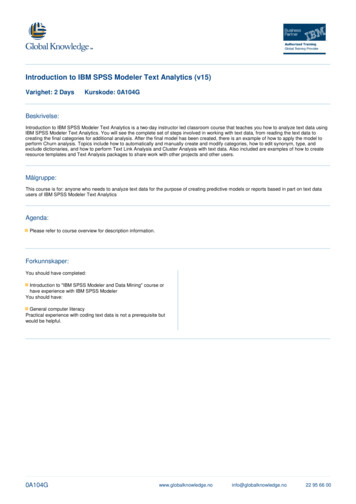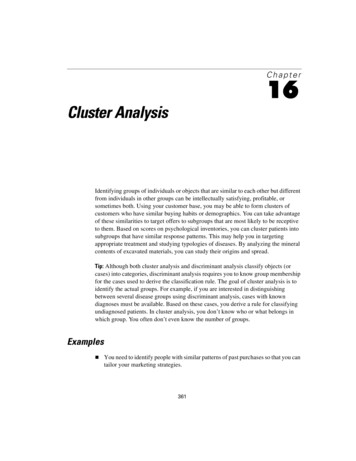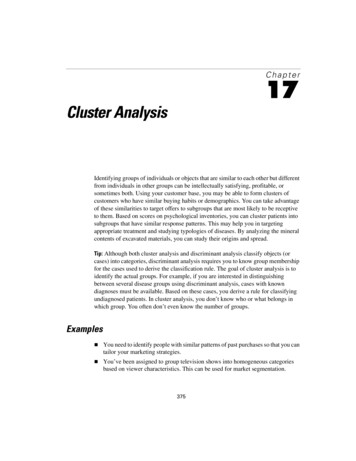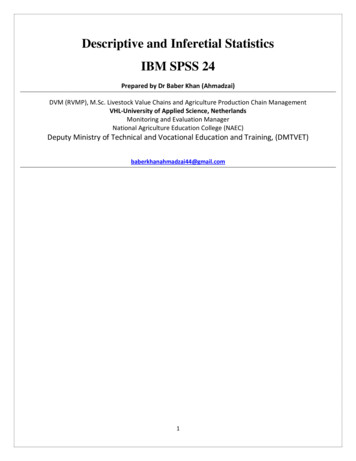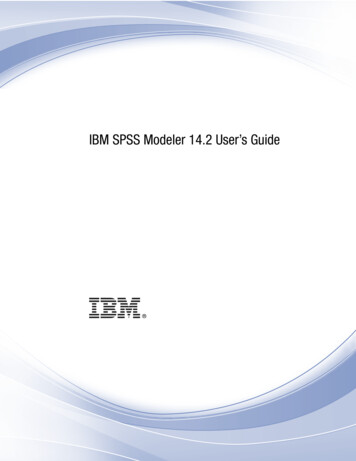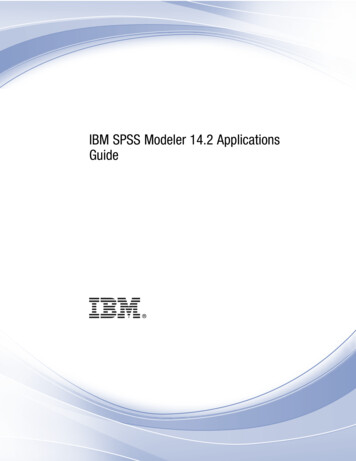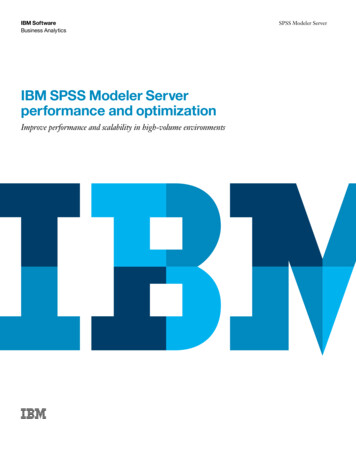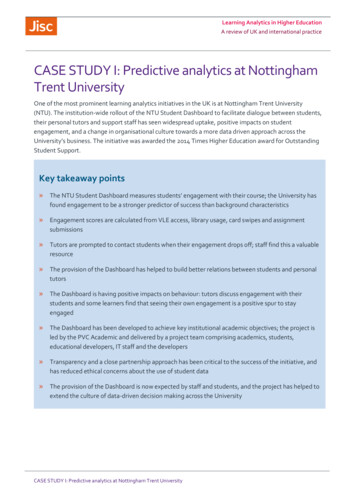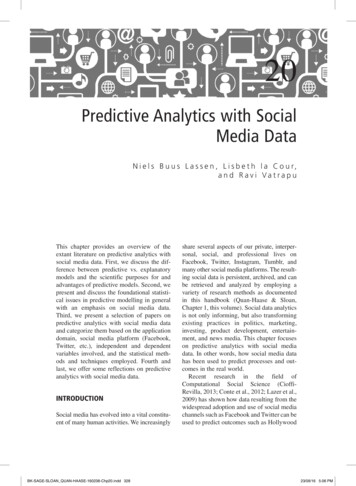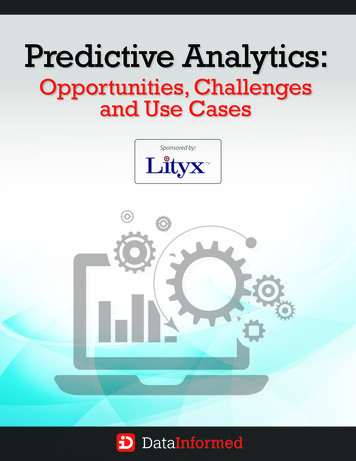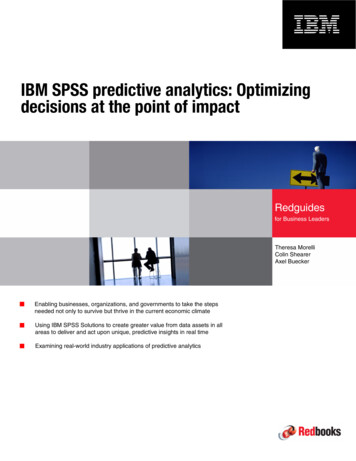
Transcription
Front coverIBM SPSS predictive analytics: Optimizingdecisions at the point of impactRedguidesfor Business LeadersTheresa MorelliColin ShearerAxel BueckerEnabling businesses, organizations, and governments to take the stepsneeded not only to survive but thrive in the current economic climateUsing IBM SPSS Solutions to create greater value from data assets in allareas to deliver and act upon unique, predictive insights in real timeExamining real-world industry applications of predictive analytics
Executive overviewPredictive analytics helps connect data to effective action by drawing reliable conclusionsabout current conditions and future events. It enables organizations to make predictions andthen proactively act upon that insight to drive better business outcomes and achievemeasurable competitive advantage.In this IBM Redguide publication, we explore IBM SPSS Predictive Analytics softwareboth at a capability level and in the context of real-world application within various industries.We address the full suite of IBM SPSS Predictive Analytics software: IBM SPSS Data Collection for capturing attitudes, preferences, and feedback IBM SPSS Statistics Suite for research and analysis IBM SPSS Modeler for predicting future behavior IBM SPSS Text Analytics for mining unstructured data sources IBM SPSS Decision Management for optimizing operational decisions IBM SPSS Collaboration and Deployment Services for enterprise-wide management ofanalytical assets and resultsThis document includes examples of solutions using IBM SPSS Predictive Analytics, keyconcepts central to enterprise-wide adoption of predictive analytics, and architecturalsamples for proven predictive solutions. Copyright IBM Corp. 2010. All rights reserved.1
A need for a new approachBusiness leaders know that to meet their goals for profitability, revenue, cost reduction, andrisk management, especially in the current economy, they cannot continue to operate the waythey have in the past. Today’s marketplace involves an exponential increase in the numberand source of customer interactions; it is now a high-volume, multi-channel game.Organizations have to find new ways to compete and use technology to become smarter.Through better management and use of information, business leaders can remove the blindspots that hinder informed decisions, and also achieve the next generation of efficiencies byproviding precise, contextual analytics and insight at the point where these items can make adirect impact on business (point of impact). Doing so can enable micro-optimization,improving insight into patterns of customers, processes, and businesses, and deliver betterreal-time decisions and actions in every area of the organization.This micro-optimization is made possible by establishing well-constructed processes andempowering individuals throughout the organization with pervasive, predictive real-timeanalytics. This approach can help shift from a sense-and-respond focus to a forward-lookingpredict-and-act focus. This approach also moves analysis from a back-office activity limited toa handful of experts to an approach that can empower everyone in the organization at thepoint of impact and in the context of the current situation. The result is rapid, informed, andconfident decisions and actions throughout the organization, based on consistent and trustedinformation.Analytics for a Smarter PlanetAs a key element of enabling smarter decision-making through advanced analytics, SPSSwas acquired by IBM in October 2009. SPSS had established itself as a leader in predictiveanalytics; SPSS drove the vision of predictive analytics and the emergence of this market. Inits over 40-year history, though, the SPSS aim has been the same: to drive the widespreaduse of data in decision-making.IBM SPSS Predictive Analytics (Figure 1 on page 3) is a software portfolio that provides datacollection, statistics, predictive modeling, and deployment capabilities. These capabilitiesenable the end-goal of improving outcomes through decision management. IBM SPSSPredictive Analytics, collectively, is the combination of various capabilities that integratemultiple data sources for statistical, mathematical, and other algorithmic analyses, anddecision management, which effectively deploys these predictions and allows actions to betaken based on these analytical insights. The results are higher quality decisions, measurablybetter outcomes, and higher returns on investment.2IBM SPSS predictive analytics: Optimizing decisions at the point of impact
Figure 1 Predictive analytics overviewThe evolution of decision-makingHistorically, decisions have been made on the basis of anecdotal experience, or hunches, ofseasoned domain experts. These “gut feel” decisions, though, are subjective and ofteninconsistent, thereby limiting their value.Having the need to standardize key decisions and make them more consistent and reliable,many organizations have moved toward automated decision-making by using business rules.Although this automation provides a degree of efficiency and objective consistency, andimproves the collective quality of decisions, static rules quickly obsolesce in ever-changingsituations and conditions, and the limits of this approach become apparent.Predictive decision-making, based on analysis of historical patterns and current conditions, isthe basis for the highest quality means of making decisions. The reasons are because themodels consider all available data, and also continuously adapt to new information, becomingsmarter over time. With predictive analytics, the right decision for the given conditions can bemade at the point of impact at the time when the decision needs to be made. Decisions arenow customized for each unique case, rather than using generalizations for the aggregate.Figure 2 on page 4 depicts how decision-making continues to change.3
Figure 2 How decision making is changingWhy predictive analytics: The real ROIThe power of predictive analytics in driving optimal outcomes and profitable revenue growth isclearly demonstrated by organizations that deploy predictive solutions. An independentfinancial impact study by IDC1 found that the median return on investment (ROI) for theprojects that incorporated predictive technologies was 145%, compared with a median ROI of89% for those projects that did not.An independent assessment of SPSS customers found that 94% achieved a positive ROI withan average payback period of 10.7 months. Returns were achieved through reduced costs,increased productivity, increased employee and customer satisfaction, and greater visibility.Flexibility, performance, and price were all key factors in purchase decisions.2IBM offers strong capabilities in information management, reporting and analysis, and withthe addition of SPSS, now can offer users predictive power that leverages both structured andunstructured data3. This provides IBM SPSS users a distinct advantage as advancedanalytics becomes a mainstream table stake in today’s hyper-competitive marketplace.1234IDC Report: Predictive Analytics Yield Significant ROI - SPSS Inc., 2004, available athttp://www.spss.hu/home page/idcreport.htmNucleus Research Report: The Real ROI of SPSS - SPSS Inc., 2005, available athttp://www.spss.com/home page/NucleusResearch.htmNucleus Research Report: IBM and SPSS: Analytics for Everyone, 2009, available M-and-SPSS-Nucleus.pdfIBM SPSS predictive analytics: Optimizing decisions at the point of impact
Current business challengesThis section describes typical business challenges that organizations face today in gainingactionable intelligence from their operations to optimize decisions and improve outcomes.Universal challengesIssues that are common to many organizations, regardless of industry include the ability tomake high quality decisions, departmental silos throughout the organization and “rearview”thinking (for example, driving by looking only in the rearview mirror).Decision-makingThe ability to make high quality decisions is central to any organization. As the volume,variety, and velocity of information expands, this ability becomes increasingly difficult. Withthe state of current data explosion, decision-makers have to respond more quickly and withgreater precision than ever.As technology of all types becomes more robust and sophisticated, the data that is generatedspans a multitude of formats, many of which are unstructured and machine-generated (forexample, surveillance systems, GPS systems, and others). This situation forces a change inhow data is managed so that it is meaningful in decision-making; organizations must look atways to sort through the data, understand and connect the key pieces of information, anddrive smarter business outcomes by leveraging the information assets.Departmental silosMany organizations develop natural silos based on various business functions, for example,finance marketing and sales, risk management, or operations. These departments often useseparate systems to manage their business objectives, and when considered individually,they can realize a certain degree of effectiveness for driving various objectives. However,when information is not shared among departments, a significant opportunity to realizesynergistic benefits is lost. For example, perhaps a marketing department is measuring targetconversion rates for a particular campaign, but does not have visibility into which prospectsmight be bad credit risks and ultimately cost the organization money.Although organizational, cultural, or political issues can be factors, this disconnect betweendepartments is often a result of the existence of multiple disparate systems within anorganization that articulate critical data in different ways: finance data is not directlymeaningful to marketers; supply chain and assortment planning data is not expressed thesame way as a customer profile. These various views and representations between systemsperpetuates the silos and inhibits cross-departmental intelligence. To mitigate this issue, dataof all types from multiple sources and systems must be integrated into a common vocabularythat is universally meaningful.Rearview thinkingTraditional forecasting and business intelligence is grounded on historical data, whereexpected future outcomes are based on what has happened in the past. This method wouldbe reliable if all conditions and variables of a given experience remain absolutely static, whichis clearly impossible given the dynamic nature of people, economies, environmentalconditions, technologies, and other variables that affect every decision point in anorganization’s operation.Historical data does become critical in decision-making when it is combined with current dataand continuously refreshed with new information. This approach is the basis of predictive5
decision-making; models are based on what has happened and why, and also on what ishappening now and what will likely happen next.Limitations of traditional approachesThis section describes the ways in which traditional approaches are limited, including types ofdata used, inability to personalize communications, and a general need to move beyondtraditional ways that analytics are positioned within an organization.Disparate and incomplete dataMany traditional systems, such as those that generate customer interactions, forecastinventory needs, or support public safety, often rely on broad segmentation and historical datathat generalize, rather than personalize, customers and constituents. These forms ofhistorical data may include demographic data and transactional history and are oftenexpressed in structured formats that allow for fundamental analysis (slicing). However,because behaviors are motivated by a variety of dynamic human factors that extend beyondstatic datapoints, relying on such data provides an incomplete picture. This is particularly truewhen considering the rich insights that are available in many unstructured formats that areoverlooked in fundamental analytic solutions. These data types, which comprise the vastmajority of available data, provide critical insights into motivations behind various behaviorssuch as preferences and desires of customers.This attitudinal data is the key to differentiating customers within a larger segment. Forexample, individuals living in a particular postal code might differ significantly in their reasonsfor living there (convenience, proximity to job and family, culture and weather, and so on).Understanding the underlying reason for a particular behavior unlocks the insights inotherwise static datapoints that allow for prediction of future behaviors.Similarly, visibility into performance and metrics using business intelligence (BI) tools iscritical to managing performance, as is the ability to perform financial analysis. However, if thedata is incomplete (that is, limited to historical instances only), the ability to make high-qualitydecisions throughout the enterprise becomes severely limited.One-size-fits-all and one-way communicationThe systems through which an organization interacts with “the world,” for example, with itscustomers or constituents, often convey single, undifferentiated messages and usuallysupport only a one-way flow of information. This approach misses opportunities to tailorcommunication and to learn from interactions.Standard customer relationship management (CRM) systems, for example, are fundamentalto managing customer interactions. They ensure that interactions occur consistently (oftenthrough automation) and efficiently, and are recorded. However, these CRM systems alsohave severe limitations with regard to understanding individual customers and creatingcustomized interactions that will ultimately be more effective and profitable. They often stop atthe one-to-many level rather than offering the finer-grained differentiation that creates aone-to-one customized experience. Traditional systems are also often unidirectional: they“shout” offers at customers with little attention to personalization.The need for a paradigm shiftTrue predictive capability is absent, or at best rudimentary, in traditional industry solutions. Asa result, organizations focus on sensing and then responding to issues, which is a reactivestance. Often, the damage (churn, fraudulent activity, excessive marketing spend) hasalready occurred, and the goal then becomes to minimize the impact on the organization.Traditional organizations also often rely on the instinct and intuition of resident experts rather6IBM SPSS predictive analytics: Optimizing decisions at the point of impact
than using objective evidence that is grounded in data to guide decision-making despite theempirical evidence showing that statistical models consistently outpredict the experts. Manyanalytical systems also often require specialized skills or training, limiting their use to a selectnumber of individuals within an organization and constraining the analytic activity toback-office functions rather than positioning it at the critical point of impact.Automation is alsowidely touted in traditional systems. Although the ability to automate is important, even moreimportant is the optimization of decisions, or making the right decision at the right moment(Figure 3).Figure 3 Addressing new business challenges with business analyticsSector considerationsThis section has information about perspectives and operational objectives of the private andpublic sectors.Private sectorMost commercial organizations share similar goals: attract the best, most profitablecustomers; grow the business through cross- and up-sell; retain high quality customers;minimize risk to the organization; and detect and prevent fraudulent activity. Supply-chainconsiderations, such as effective assortment planning in retail stores and efficient productionlines in manufacturing, are also key considerations that can significantly affect the customerexperience and ultimately affect customer value. In short, the goal is to grow revenues andminimize costs, thereby producing profitable revenue growth.Typical application areas are as follows: Attracting the best, most profitable customers through well-targeted campaigns. Increasing revenues through cross- and up-sell to new and existing customers. Reducing defection of high-quality customers and, conversely, identifying those who arecostly and should be allowed to go through attrition. Minimizing the effect of fraudulent activity by focusing the work of investigatorsappropriately. Increasing customer satisfaction through faster response and processing of legitimateclaims.7
Building customer loyalty through effective and reliable inventory management. Reducing operating costs by predicting maintenance needs proactively.Public sectorPublic agencies manage a unique set of challenges and often face additional scrutinybecause of the personal nature of public security, healthcare, and education. Because theyare also often funded or subsidized by government-run agencies, these organizations faceadditional pressures and bureaucracy around operational budgets.Typical public sector application areas are as follows: Government agencies manage functions as diverse as tax audit selections, military forcerecruitment, and proactive policing and public safety. Healthcare organizations seek to proactively manage their resources and fine-tune theirpractices to provide better patient care. Colleges and universities manage the entire student life cycle more efficiently, recruitingthe right mix of students, offering students a selection of programs and assistance to keepthem enrolled, and managing alumni development programs with greater success.8IBM SPSS predictive analytics: Optimizing decisions at the point of impact
Industry examplesThis section has information about functional requirements and challenges of specificindustries, and describes predictive analytics solutions to address the gaps that currentlyexist. Industries include consumer banking, insurance, telecommunications, retail,distribution, industrial, and the public sector.BankingThis section describes the business and functional requirements of the banking industry, andoffers examples of how IBM SPSS Predictive Analytics can address those industry-specificneeds.Business and functional requirementsBanks today are faced with a low or declining share of wallet, rising marketing costs becauseof low response rates and unprofitable campaigns, and a general inability to effectivelysegment and target customers. Banks struggle to understand the needs of individualcustomers and therefore often manage interactions and offers at the aggregate level. As aresult, campaigns are poorly targeted and marketing costs often exceed budgets, while leadgeneration goals still are not met. Within operations, banks often implement multiple systemsfor lead-sharing, reporting solutions, and a metric tracking mechanism, which ultimatelyprevents effective and accurate information-sharing throughout the enterprise.Banks are also under increasing pressure to minimize risk and focus on customers andprospects that will be profitable, rather than result in costly liabilities. Although banks typicallyhave large, multiple data warehouses for risk and compliance, complex and inflexiblerisk-modeling methodologies prevent effective use of this information. The ability to predictwho will be high risk is critical, driving the need for a platform that synthesizes disparate riskand finance data, and predicts which customers will be risky, and with whom they should notdo business.Information technology (IT) executives within the banking sector typically look to maximizereturns from investments in warehousing and CRM, and find new and innovative approachesfor supporting business goals. Within the lines of business (LOB), departments look to betterunderstand buying preferences,
IBM SPSS Text Analytics for mining unstructured data sources IBM SPSS Decision Management for optimizing operational decisions IBM SPSS Collaboration and Deployment Services for enterprise-wide management of analytical assets and results This document includes examples of solutions using I

